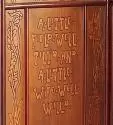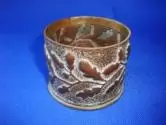“Is That An Arts & Crafts Antique?”
 A Reader’s Question: My friends and I have “spirited discussions” over what constitutes an Arts and Crafts antique.
A Reader’s Question: My friends and I have “spirited discussions” over what constitutes an Arts and Crafts antique.
We all collect furniture, pottery, textiles and metalware of the period, but two categories of items have us stumped: World War I trench art (e.g., decorated shell casings, see photo) and pyrographic items (e.g., glove boxes). Both were made during the A&C period, but they seem to be shunned by most collectors and, therefore, don’t command a lot of money.
One category that I’ve added to my list as I scour antique malls are signed and dated china painting items (usually plates) with A&C themes or stylized decoration. Some of them are really well done but, again, seem to be off the radar for a lot of collectors. Your thoughts?
Answer: I would add to your list projects done in manual arts classes, as well as home-crafted items, including furniture, pottery, metalware, textiles and leatherwork.
Jean Oberkirsch curated a great display of home-crafted Arts & Crafts items at the Grove Park Inn Arts & Crafts Conference a few years ago, demonstrating that these unsigned pieces are clearly Arts & Crafts in style, technique, motif and philosophy: Head, Heart and Hand.
While not always as sophisticated as mainstream Arts & Crafts, they are often more personal in nature. And while Stickley and Limbert furniture was produced by the thousands in factories, these hand-made textile kits, decorated shell casings (which is how Dirk van Erp got started), footstools and painted china are one-of-a-kind personal statements.
The fact that they are over-looked and under-priced is good news for every Arts & Crafts collector who is not intent on creating a museum of only signed masterworks from the Arts & Crafts era.
Keep looking – and adding these gems to your home!
– Bruce
(The lower pyrography photo courtesy of Style 1900 magazine.)

